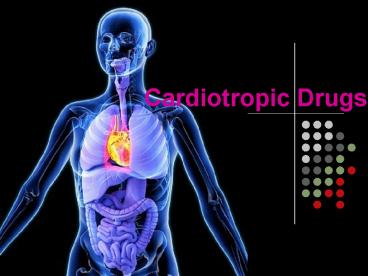Cardiotropic Drugs - PowerPoint PPT Presentation
1 / 16
Title:
Cardiotropic Drugs
Description:
Cardiotropic Drugs Cardiotropic Drugs used for Congestive Heart Failure and for Cardiac Arrhythmia I. Digitalis Glycosides Digoxin Digitoxin Digoxin Half-life 35 ... – PowerPoint PPT presentation
Number of Views:366
Avg rating:3.0/5.0
Title: Cardiotropic Drugs
1
Cardiotropic Drugs
2
Cardiotropic Drugs
- used for Congestive Heart Failure and for Cardiac
Arrhythmia
3
I. Digitalis Glycosides
- Digoxin
- Digitoxin
4
Digoxin
- Half-life 35 40 h
- Therapeutic Range 0.5 2 ng/mL
- Toxic Level gt2 ng/mL
- Mechanism of Action
- Functions by inhibiting membrane Na, K -ATPase
(causes a decrease in intracellular potassium,
resulting in increased intracellular calcium in
cardiac contractility)
5
- Toxic Adverse Effects
- Nausea
- Vomiting
- Visual disturbances
- Cardiac effects (premature ventricular
contractions PVC and atrioventricular node
blockage) - Route of Administration (oral)
6
- Important comments
- elimination of digoxin occurs primarily by renal
filtration of the plasma free form - in circulation, 25 is protein-bound and the rest
is sequestered into muscle cells - its therapeutic actions and toxicities is
influenced by the concentration of serum
electrolytes (low serum potassium and magnesium
potentiate digoxin actions) - Thyroid status also influence the action of
digoxin - Hyperthyroid patients resistance
- Hypothyroid patients more sensitive
7
Digitoxin
- Half-life 4 6 h
- Therapeutic Range 9-25 ng/mL
- Toxic Level gt25 ng/mL
- Important comments
- Converted to active metabolite (digoxin) in the
liver
8
II. Procainamide (Prontesyl)
- Half-life 3 5 h
- Therapeutic Range 4 10 ng/mL
- Toxic Level gt12 ng/mL
- Route of Administration (oral)
9
- Important comments
- Undergoes N-acetylation in the liver to form
N-acetylprocainamide (NAPA) which is the active
metabolite - Toxic side effects related to Systemic Lupus
Erythematosus (SLE) - Gastrointestinal absorption is rapid and complete
- Absorbed procainamide is about 20 bound to
plasma proteins - Its active metabolite can be measured by
immunoassay
10
III. Quinidine
- Half-life 5 12 h
- Therapeutic Range 2.3 5 ng/mL
- Toxic Level gt5 ng/mL
- Toxic Adverse Effects
- Nausea
- Vomiting
- Abdominal discomfort
- Route of Administration (oral)
11
- Important comments
- Measured fluorometrically (common)
- May also be determined by chromatography and
immunoassay - Undergoes hydroxylation in the liver
- Two most common formulations
- Quinidine sulfate (gastrointestinal absorption is
complete and rapid) - Quinidine gluconate
- Absorbed quinidine is 70 80 bound to serum
proteins - Elimination is through hepatic metabolism
12
IV. Lidocaine (Xylocaine)
- Half-life 2 h
- Therapeutic Range 1.2 5.5 µg/mL
- Toxic Level gt5.5 µg/mL
- Important comments
- A local anesthetic
- Undergoes N-dealkylation in the liver
- Not protein-bound
- Not stored in tissues
13
V. Propanolol (Indiral)
- Half-life 3 h
- Therapeutic Range 50 100 ng/mL
- Toxic Level gt100 ng/mL
- Important comments
- Toxic effect Raynauds type
14
VI. Disopyramide
- Important comments
- Commonly used as quinidine substitute when
quinidine adverse effects are excessive - Orally administered
- Gastrointestinal is complete and rapid
- Eliminated by renal filtration, and to a lesser
extent, by hepatic metabolism
15
- Toxic Adverse Effects
- Anticholinergic effects (gt4.5 µg/mL)
- Dry mouth
- Constipation
- Cardiac Effects (gt10 µg/mL)
- Bradycardia
- Atrioventricular node blockage
16
Thank you for listening!

